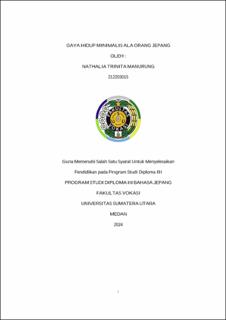| dc.contributor.advisor | Barus, Murniati Br | |
| dc.contributor.author | Manurung, Nathalia Trinita | |
| dc.date.accessioned | 2024-09-30T09:04:07Z | |
| dc.date.available | 2024-09-30T09:04:07Z | |
| dc.date.issued | 2024 | |
| dc.identifier.uri | https://repositori.usu.ac.id/handle/123456789/97960 | |
| dc.description.abstract | This writing discusses problems related to the Japanese minimalist lifestyle. The purpose of this writing is to explain how the principles of life, life practices, benefits of life, obstacles and strategies for minimalist living and the Japanese minimalist lifestyle are influenced by Zen. The method used in this writing is the library method. The result obtained from this writing is minimalist living, namely having what makes us happy. We can call it simple living. Living by having what we need, although not in large quantities. However, because the conditions are adjusted to individual needs, meeting needs becomes the main priority. A minimalist lifestyle is about having less stuff and keeping what is truly important and necessary | en_US |
| dc.language.iso | id | en_US |
| dc.publisher | Universitas Sumatera Utara | en_US |
| dc.subject | Lifestyle | en_US |
| dc.subject | Minimalist living | en_US |
| dc.subject | Main priorities | en_US |
| dc.subject | Life principles | en_US |
| dc.title | Gaya Hidup Minimalis Ala Orang Jepang | en_US |
| dc.title.alternative | Japanese Minimalist Lifestyle | en_US |
| dc.type | Thesis | en_US |
| dc.identifier.nim | NIM212203015 | |
| dc.identifier.nidn | NIDN0025038205 | |
| dc.identifier.kodeprodi | KODEPRODI79404#Bahasa Jepang | |
| dc.description.pages | 41 Pages | en_US |
| dc.description.type | Kertas Karya Diploma | en_US |


